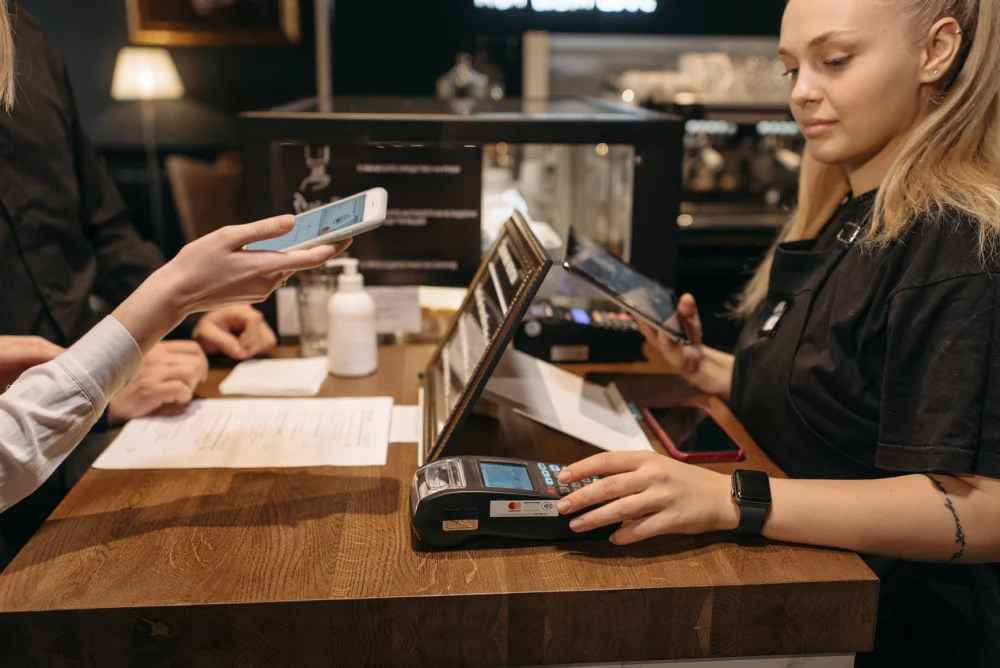Ready to get started?
Get paid faster and save up to 50% on fees with Pay by Bank.
Is your retail business feeling the sting of online giants like ASOS and Boohoo? Or are brick-and-mortar blues hitting hard? Don’t worry; the high street isn’t dead – it’s evolving. Insider Intelligence reported last month that retail e-commerce sales will grow 10.1% YoY, while non-e-commerce sales will only grow 2.0% YoY. But there’s no need to panic, as it’s the best time to take your retail business online. That’s why we’re here to supercharge your high street hustle and help you go digital.
Whether you’ve been wondering how to start a retail business or want to take your existing one online, we’ve got a toolkit of actionable strategies for you to rise above the noise and make it in e-commerce. It’s time to give that “doom and gloom” narrative the boot and rewrite your retail store for 2024 and beyond. Forget sleepy strategies and tired tactics. We’re diving into unconventional online retail business ideas, exploring innovative ways to make money without an inventory, and uncovering the secrets behind building a digital store that checks out in 2024.
Are you ready? In this article, I will explore:
- What online retail businesses are and why they matter
- The four pillars of online retail and what to focus on in 2024
- How to take your business online without having tons of stock
- How Atoa can help
What really matters in online retail?
If you’re here, then you know you need to bite the bullet and inject a little fire into your retail business. The UK online retail landscape will be influenced by several key trends this year that businesses need to take note of. But what does that look like for success in 2024?
Let’s break this down into some manageable pillars.
Pillar one – meet your customers’ expectations
Customers are looking for hyper-personalised shopping experiences across online, mobile, and offline channels. This means using customer data to offer relevant product recommendations, targeted messaging, and loyalty programs.
And you’ve got to make it omnichannel. Basically, think of it as a retail experience you’d want for yourself. If you buy something online and you’re walking past the shop in a few days, would you instead pick it up sooner and cheaper or get a delivery? It’s often as simple as reflecting on your wants and needs and building up from there.
How to make your business omnichannel
- Easy click-and-collect: Customers can place orders online and then choose to either visit your store, collect their orders from lockers, or set pickup points.
- On-demand stock levels: Help shoppers track and check stock, request stock notifications, and offer personalised recommendations if what they want is unavailable.
- Consistent brand image: Whether customers browse in-store or online, show them the same brand messaging, visuals, and values to build trust and loyalty.
Fast delivery options, easy returns, and a host of different payment methods (including Buy Now and Pay Later) will continue to be an important choice. As environmental issues and social responsibility become more transparent, we predict customers will seek out eco-friendly and ethically sourced products more than before.
Action you can take to move forward
- Use AI-powered product recommendations from customer data and browsing history to offer personalised suggestions on your website and communications. For example, help customers find perfect gifts using a chatbot.
- Partner with local delivery providers to offer same-day or next-day delivery options at fair prices. Mintel data in 2023 revealed that the UK express delivery market value in 2023 was still 15% above pre-pandemic levels. It’s a luxury customers have got used to, and you can’t afford to miss it.
- Develop a mobile app for user-friendly browsing, ordering, tracking, and rewards.
- Invest in your team with training and development opportunities. Happy and knowledgeable staff are more likely to create a positive customer experience.
- Source eco-friendly products, offset carbon emissions, and share information about your supply chain with customers.
Pillar two – adapt to the changing market
Rising living costs and economic uncertainty mean promotions, discounts, and loyalty programs will draw customers in. This can help your retail business stand out in a crowded market with authentic products and engaging customer experiences.
Personalising your online retail business is a must
In 2024, generic and washed-out experiences are a thing of the past. Customers crave personalised goods and services that make them feel valued and understood. Remember, personalisation shows customers that you care. Let your audience feel like you recognise their needs, and they’ll likely reward you with loyalty.
How to use personalisation in your business
- Create benefits to reward regular customers with discounts, free shipping, and exclusive offers. Don’t forget to reach your audience with targeted email campaigns and social media ads.
- Consider clever ideas like subscription boxes or recurring orders built around your customer preferences or data for regular and predictable revenue.
- Explore alternative targeting methods like first-party data and collaborations with brands like yours.
- Build a sustainable future with ethical sourcing and eco-friendly practices, and don’t forget to shout about it by partnering with local suppliers, communities, and influencers to share your message.
- Recommend products based on past purchases and browsing behaviour.
Distributed commerce – be everywhere, sell everywhere
2024 means it’s time to promote your products across multiple channels. Get your offerings plastered across online marketplaces, price comparison sites, Google Shopping, and beyond.
- Export your product feed and showcase your offerings on various platforms – get discovered by new customers who might not have found you before.
- A wider audience means better reach. Attract an array of customers and tap into undiscovered or niche markets. Remember, tastes and preferences change, so doing this can future-proof your business.
- Dive into social commerce to sell directly on Instagram, TikTok, and more and reach new audiences. Hook customers in with live product demonstrations and events.
- Track sales across these channels to identify your high-performing platforms and optimise their strategy for the best impact. Don’t waste time on anything that doesn’t deliver!
- Sell advertising space on your website or app to other brands for any easy new revenue stream.
Action: Don’t be afraid to experiment. Use different platforms, monitor performance, and double-up on what works. Things move fast in retail, so you need to adapt to stay in the race.
Pillar three – push the boundaries
Go beyond the basics with new technology that boosts your online presence. Don’t be afraid to do things differently. The retail landscape is constantly evolving, so staying ahead of the curve is crucial to making your brand relevant in a digital world.
And here’s how to do it
- Provide 24/7 customer service without keeping your staff up all night. AI-assisted chatbots can answer frequently asked questions and send any complex issues to your inbox.
- Develop an augmented reality (AR) app so customers can see how clothes fit or place furniture in their homes before they buy. This can encourage sales and also reduce the return rate for a cash flow boost.
- Use voice search optimisation to make your website discoverable for “near me” and voice-activated searches.
- Create overlapping online and offline AR experiences to drive foot traffic into brick-and-mortar stores.
- Stream in-store events with influencers or product experts online to demonstrate how products work for a spike in sales. Invite guests down to join in and let customers watch from home for a hybrid approach.
Innovation isn’t just about groundbreaking tech; it’s also about finding solutions that improve your customers’ experience. The time is now, so be bold and don’t hesitate to experiment with new technologies.

Pillar four – make sure your payments are up to speed
You don’t have to settle for long wait times or steep fees. An online retail business needs razor-sharp payments, and future-forward solutions like QR code payments can save you time whilst boosting your bottom line. Fast, fair, and secure payments for your UK business in 2024 require a two-pronged approach: choosing the right payment solutions and following best practices.
How to choose the right payment solution
The best retail payment solution is out there and waiting for you. To find it, put contactless in-store payments like mobile wallets, QR codes, and payment apps at the top of your list. Consider alternative payment methods too. Start by exploring buy now, pay later (BNPL) services or open banking payments to save on fees and boost customer convenience. Accepting cards is still a good idea, so regularly compare providers based on transaction fees, contract terms, and features they offer.
Online retail payments need a payment gateway, so find one with transparent fees, integrations, and other handy features. You can also partner with a merchant account for competitive rates, fast settlements, and good customer service. Compare fees, contract terms, and minimum monthly volumes before signing up. Plus, don’t be afraid to negotiate fees with payment processors and providers, especially if you have high transaction volumes. Find out why you might not need a merchant account.
How to follow best practices
Number one is security. PCI compliance for both in-store and online transactions. Regularly update software and hardware, use strong passwords, and encrypt sensitive data.
Always be transparent. Display your payment options before checkout and make sure customers understand transaction costs. If you’re comfortable, you can also pitch QR code payments to customers to save your business on fees.
But keep customer experiences at a high level. Make the payment process smooth and easy to complete. Have a few payment methods available so customers can pay if they forget their card or one of your systems is broken. Nobody wants a trip to the cash machine when it’s raining!
Finally, it’s always worth seeking expert advice or asking other business owners how they approach payments. There’s no one-size-fits-all answer. Research, compare options, and choose solutions that align with your business model, size, and budget. By following these tips and staying informed about evolving trends, you can ensure your UK business payments are up to speed in 2024 and beyond.
So there you have it – the four pillars to keep your retail business standing strong.
Other things to consider
But wait, there’s more! We’ve got even more tips to help your business go digital.
️Mobile-first wins the race
Smartphones aren’t just for social media. In 2024, mobile devices will be the primary shopping tool.
- Check your business website is mobile-friendly and loads quickly. Frustrated customers won’t convert into purchases…
- If you have a mobile app, make it engaging and easy to use by offering in-app features, rewards, and discounts to push downloads and use.
- Being active on social media is essential. Use the right platforms to let customers discover and purchase your products on the go. Have you seen our article about how to use WhatsApp Business? It’s a must-read.
Remember, showing up on mobile is essential for a healthy business in 2024. Make sure you’re optimised across the board and watch your sales climb.
Introducing these strategies to your digital activity can take your UK retail business to new heights. Remember, the future is brighter for companies that adapt to change, grow with their customer’s needs, and share products with a purpose. So, make it your objective.
Content is key
Compelling content can be a strategic win, and if you’re creative, it can be done cheaply. In 2024, customers will be overwhelmed with information, so cut through the noise and capture their attention with content that counts.
Here’s how to craft content that resonates in online retail:
- Craft authentic brand stories: Showcase your values and unique products. Don’t be afraid to get personal!
- Embrace diverse content formats: Use blog posts, infographics, videos, and user-generated content to keep things fresh.
- Optimise for SEO: Make your content is discoverable by using relevant keywords and meta descriptions.
- Share content across the right channels: Focus on platforms your customers use and engage with your audience to make your social media presence pop.
Online content marketing is a long game, but the rewards are worth it. If done correctly, content can be the voice of your brand to build community, boost brand awareness, and drive sales.
There has to be a boring part, and here it is. As the use of third-party cookies slows, businesses will need to navigate stricter data privacy regulations like GDPR and find alternative ways to target customers.
Running an online retail business without inventory
Has your spare room turned into a stockroom? If so, it’s time to reclaim it with an inventory-free business model. Before we sign off this post, let’s take a quick look at some exciting business ideas without physical stock holding them back. Another huge benefit of not having inventory is that you can work from anywhere, making it an ideal money-making opportunity for remote workers. Choose a model that aligns with your skills, then let the funds flow with a few of these options.
- Dropshipping: Partner with suppliers who hold and ship products for you on-demand, minimising the risk and cost to you. Letting suppliers handle inventory and shipping means you can focus on marketing your online store and provide great customer service. Find out more about what dropshipping is.
- Print-on-demand: Sell custom-designed products like apparel, accessories, or home decor without managing physical stock. Focus on creative design and let customers choose designs online to print themselves.
- Curate and sell downloadable products like ebooks, courses, or templates. Focus on creating valuable content and building an audience.
- Product curation: Promote products from other brands and earn commissions on each sale. Leverage your online presence and content creation skills.
- Affiliate marketing: Partner with other retailers to promote their products on your website or social media platforms without handling stock, earning commissions on sales.
- Fulfilment by Amazon (FBA): Use Amazon’s logistics expertise to store and ship products you source yourself. This requires top-tier product selection and a solid marketing plan.
Remember, this is just a starting point. Explore, research, and combine these ideas to discover an authentic business idea. With dedication, creativity, and a customer-centric approach, you can build a thriving online business even without managing inventory.
Quick online retail business checklist
Ready to launch or improve your business online? Then it’s time to get tactical.
- Find your sweet spot: Identify a profitable, unique selling point (USP) with low competition and high demand. This can be tricky, but having a fresh angle makes it easier. Research the feasibility of your idea and scope out the competition.
- One step at a time: Start small and test your concept before rolling out or scaling up. Adapt your strategies and offerings based on market trends and customer feedback.
- Nail your online presence: Craft a user-friendly website or landing page optimised for mobile and SEO.
- Content is everything: Tell your brand story with eye-catching visuals, engaging blogs, and unmissable social media updates.
- Embrace omnichannel: Mix your online and offline brand experiences to offer click-and-collect, unique recommendations, and more.
- Personalisation pays off: Pore through customer data to build promotions and product suggestions that hit the sweet spot. Focus on building strong customer relationships and offering excellent service.
- Data is your friend: Track performance, analyse results, and finetune your strategy to keep winning.
- Make the most of free online resources, courses and communities for business owners: Many offer valuable guidance, mentorship, and networking opportunities.
💡 Choose a business model that works alongside your skills, interests, and target audience. Be patient and consistent, and continuously learn and adapt to succeed in online retail.
The takeaway
Remember, the path to online retail success can be long and windy, so bring your comfy shoes! Experiment with different routes and trails, watch the landscape as it unfolds, adapt to the changing weather, and always lead the way for your customers.
The future of retail doesn’t need to be daunting if you remember our four pillars and stay ahead. Focus on the best customer experience with personalisation and omnichannel shopping. Make sure customers can pay how they want and feel secure using your online checkout. Of course, there is a lot more to consider, but if you prioritise your customer experience, then the rest easily follows.
FAQs
What are the biggest challenges facing UK retailers in 2024?
Online retail business owners face a storm in 2024 ranging from cost-of-living squeezes, disrupted supply chains, and shifting consumer demands. Inflation and Brexit add uncertainty, while online giants and sustainability concerns can add extra pressure. Embracing value, personalisation, omnichannel, and eco-friendly practices are key to surviving and thriving in a competitive landscape. Adapting to changing circumstances can help UK retailers move towards a successful future.
How can physical stores compete with online shopping?
Physical stores can’t really compete on price against the big online retailers; instead, the key is to provide a human touch. So, take advantage of your physical space if you have one. Take it online with curated selections, personalised service, and interesting events or showcase unique products, host workshops, and build a community. Let customers try, touch, and discover in-store, then order conveniently online for delivery or collection. Position yourself as a destination for convenience, experience, and expertise beyond what a screen can provide.
How will delivery and fulfilment evolve in the future?
Retail delivery is heading towards faster and greener options. Expect mini local warehouses for quicker deliveries and robots delivering packages. Sustainability will be essential, with eco-friendly practices and inventory aided by AI predictions. The future of delivery will be hyper-convenient and tailored to your needs every step of the way.
How we can help your online retail business
Whether you need to collect funds in-store, online or remotely – Atoa has the answer. We’re a low-fee alternative to card payments with instant payout and no contracts that can make your omnichannel dreams come true.
Choose fair payments that work for your business. Give Conor a call to find out more and get a quick product walkthrough.




